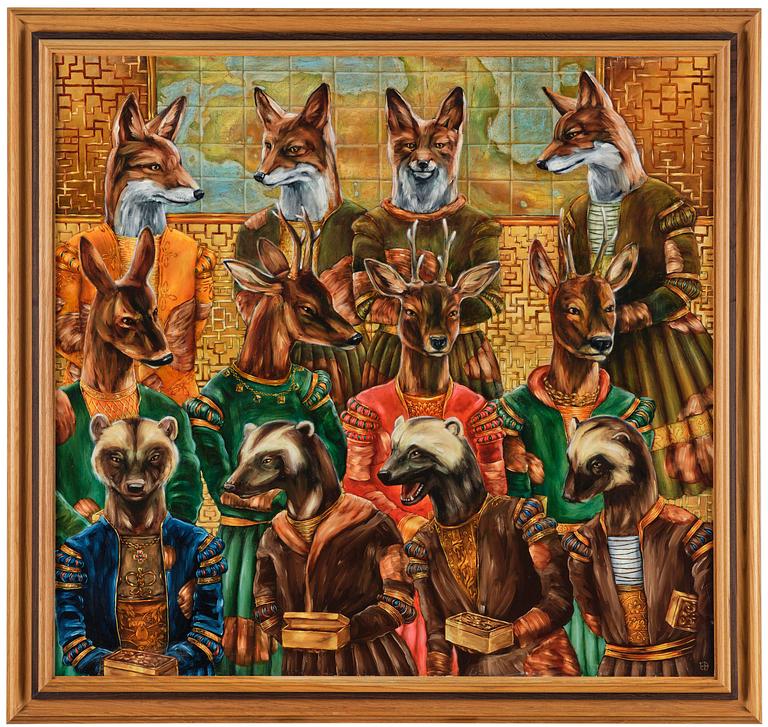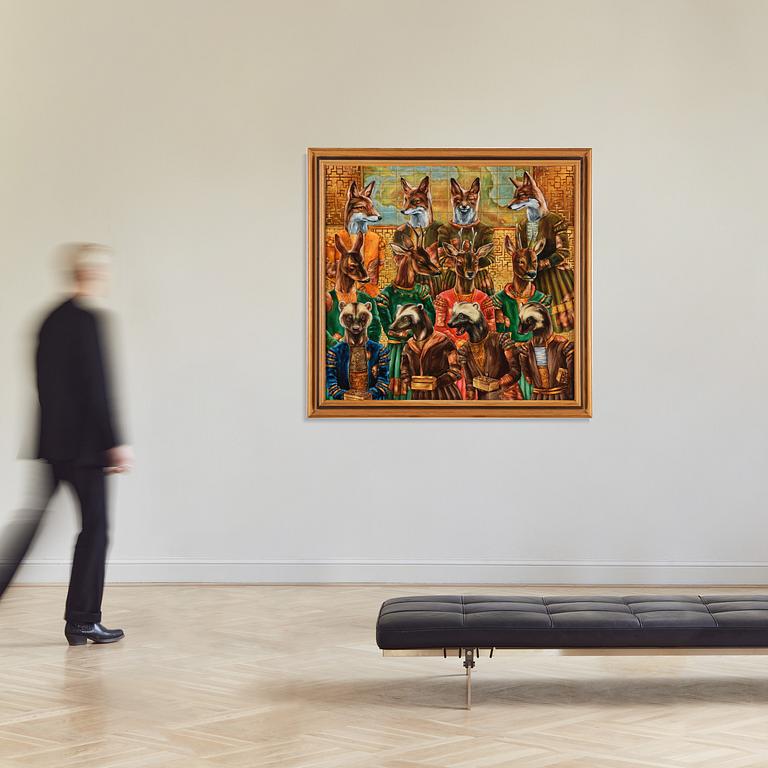Ernst Billgren
"Från Adrianopel till Astrabad"
Signed EB. Executed in 2006. Oil on panel in artist's frame 174 x 183 cm.
Provenance
Galleri Lars Bohman, Stockholm, "Tjuvar", 2 September - 1 October 2006.
Literature
Galleri Lars Bohman, "Ernst Billgren - Tjuvar", 2006, illustrated full-page p. 21.
More information
"From Adrianople to Astrabad" from 2006 is a central work in Ernst Billgren's oeuvre. The painting serves both as a manifesto of his thematic world and a summary of the blind alleys he has laid out for viewers over his career. Its monumental format and impressive richness of detail immediately transport us into his playful and peculiar realm, populated by his characteristic animal figures.
The painting was included in Billgren's acclaimed exhibition "Tjuvar" (Thieves) at Galleri Lars Bohman in Stockholm in 2006, where he allowed the animals, with their carefree expressions and splendid attire, to take centre stage in the sophisticated environments of humans. The catalogue was cleverly arranged, and the paintings were accompanied by excerpts from interrogation protocols from investigations of thefts, where the thieves, with all manner of absurd excuses, attempted to justify their actions. In connection with the release of the graphic portfolio "Tjuvar" in 2007, Billgren commented: "Like a thief in the night, nature enters our homes without first knocking on the door, just as we once took over nature, felled its trees, dug holes in the mountains, and stole the inhabitants of the forest; it now stands stamping in our porches for a return visit. What are they doing here? What will they take with them? Like thieves in the afternoon, the animals have dressed in their finest clothes to reclaim what they perceive as theirs and can lay their paws on. Is it time to flee into the forest?"
As a debater, author, furniture designer, and filmmaker, Ernst Billgren has made an undeniable mark on contemporary art, not least with his questioning of the concept of art. Even as a young student at Valand Academy of Art and Design in the 1980s, he made a strong impression on both fellow artists and the faculty. He invited students, teachers, and professors to a performance with the question "What is the difference between good and bad art?". The turnout was large, and it ended with a lively discussion, with Billgren as moderator, where both teachers and students expressed their opinions. Since then, he has continued to fascinate and surprise both the informed art audience and a broader public with his use of unconventional methods and his many references to art history. Both as an artist and a debater, he has constantly posed questions about what art is, what its purpose is, and where its boundaries lie. He continually challenges established patterns, and his art often becomes semantic inquiries into what the definitions of our most ingrained concepts are—and perhaps what they ought to be.
Inspired by the Brothers Grimm's fairy tales, animals early on became a tool for Billgren. In his book "What is Art and 100 Other Very Important Questions," he posed the question he claims he is most often asked: "Why are you so interested in foxes?". The answer was: "Short answer: Which foxes? Long answer: If you enter a chemist's laboratory, you will surely discover lots of test tubes, and you might conclude that he is interested in test tubes. But I don't believe that. He is probably after discovering a new enzyme or element, or finding a cure for some disease. The test tubes are tools, and he likely does not see them at all and has no interest in them or in foxes."
From spring to autumn 2025, Ernst Billgren will be featured with several new works in the exhibition "Ernst Billgren – New Memories" at the Nationalmuseum in Stockholm.
Artist
Ernst Billgren was born in Stockholm in 1957 and studied at Valand Academy from 1982 up until 1987. His artistic career is marked by remarkable diversity, which is quite unique in the Swedish art scene. He is a painter, printmaker, sculptor, author, debator and also worked in film and stage design. His artistic production spans over a multitude of disciplines, encompassing painting, sculpting, set design, furniture design, literature, film, and music. Across these diverse fields is a distinguishable continuity of nature, national romanticism, and mythology. Billgren demonstrates great craftmanship by being able to work in numerous materials such as mosaic, wood, bronze, cement, tile and glass. The defining characteristic of Billgren is his his bold approach to challenging conventional ideas of what constitutes good art. He blends fine art with kitsch and introduces animals and birds into refined settings, blurring traditional boundaries.
Ernst Billgren's work is known for its ability to provoke and leave a lasting impression, ensuring that viewers are engaged and often stirred by his unconventional artistic expressions.







































































